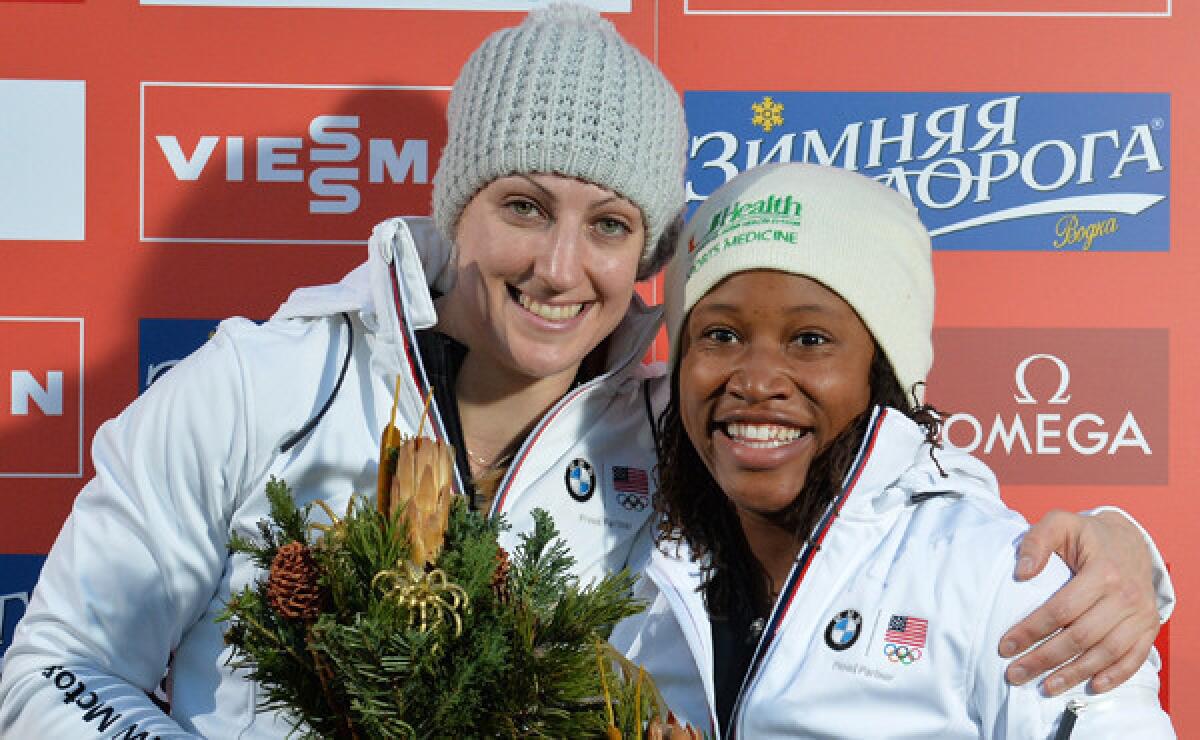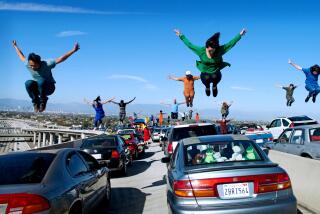U.S. bobsledder Lauryn Williams’ Olympic record has a bonus track

- Share via
Lauryn Williams’ hamstring had failed her, but her competitive spirit was undamaged.
Williams, who won a silver medal in the 100-meter dash at the 2004 Athens Olympics and a gold medal for running in the first heat of the U.S. women’s 400-meter relay at the 2012 London Games, intended to become a certified financial planner after a recurring leg injury nudged her to retire from running last June. A chance airport chat with hurdler Lolo Jones, who had made the U.S. bobsled team last season and enthusiastically endorsed the sport, piqued Williams’ curiosity enough for her to give it a try before she hung up her spikes.
So there she was last August, a dizzying few days after she had first put her hands on a bobsled, hurtling down an icy track at the U.S. push championships in Calgary, Canada.
At that moment, the financial planner gig wasn’t looking so bad after all.
“I made it through the first day — two trips — but was not optimistic about a second day,” said Williams, who packs a lot of energy and power into her 5-foot-31/4, 130-pound frame. “Heading down the track I realized just how much I didn’t know about this sport and how it was too late now.
“It was one of those ones when you say, ‘Lord, if you get me out of this bind I will never do this again.’”
But the longtime Miami resident did it again, finishing third at the competition and earning an invitation to a U.S. bobsled camp. Because she stuck with it and picked up the nuances so quickly, she will put her sprinting skills and spikes to use on a different kind of track at the Sochi Olympics.
Williams was nominated for one of three push athlete positions on the Sochi team on Sunday, hours after she had teamed with driver Jamie Greubel to win a World Cup race in Igls, Austria, and win her third medal in four races. Jones, who plans to return to hurdling, also was nominated for a push spot, as was former sprinter Aja Evans.
Greubel, who’s ranked second in the world, third-ranked Elana Meyers and seventh-ranked Jazmine Fenlator earned nominations as drivers. The driver-push athlete duos will be decided soon.
Jones and Williams will become the ninth and 10th U.S. athletes to compete in both the Summer and Winter Olympics. On that list are hurdler-bobsledder Willie Davenport and boxer-bobsledder Eddie Eagan.
Jones’ bobsled venture has drawn a lot of attention because of her good looks, adept use of social media and achingly close Olympic disappointments. She was leading the 100-meter hurdles final at Beijing in 2008 before she stumbled out of contention, and she finished fourth in London in 2012. Williams, whose career also included the 100-meter world title in 2005 and two relay gold medals at the world championships, has had more success and less attention. But fame isn’t what she’s seeking.
“I had no idea what was in store for me this season,” she said during a call with reporters after the Olympic selections were announced. “I just wanted to come in with a positive energy and help out.
“This is the first time I’ve been a part of a true team sport, and there’s somebody else counting on you. You can’t let that person down, and that’s what drives me. It’s very important to give everything I have whenever I’m on that start line.”
Competing in bobsled is less glamorous and lucrative than track and field. Sliders polish the runners of their sleds, move the nearly 400-pound sleds to the start line, and load and unload them onto trucks for transport. Williams enjoys the collaborative nature.
“I have been humbled and continue to be each day I work with these athletes,” she said by email from Germany, where the U.S. women are scheduled to compete in a World Cup event this weekend.
“Everyone is here because they love what this sport is about. It is a culture and club that isn’t for everyone, but those in it love it. We are a family and take care of each other in that manner. You make things stretch — you share your food, clothes, connections and those in your network to help a teammate out.”
As comfortable as she is, the fear on that first day remains in the back of her mind.
“I am still afraid every time I get to a new track. It is important that the driver look confident about the track or that makes me more nervous,” she said. “I have yet to crash so I am unsure of what that feeling is and don’t want to experience it.”
Twitter: @helenenothelen
More to Read
Go beyond the scoreboard
Get the latest on L.A.'s teams in the daily Sports Report newsletter.
You may occasionally receive promotional content from the Los Angeles Times.







